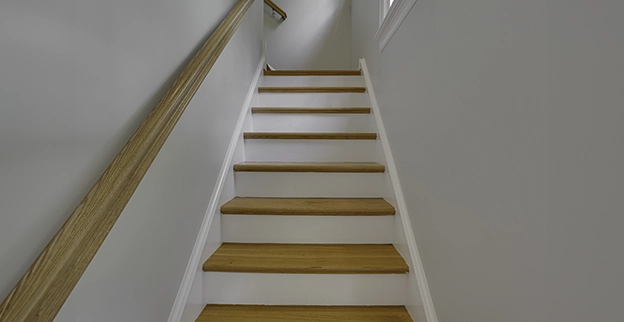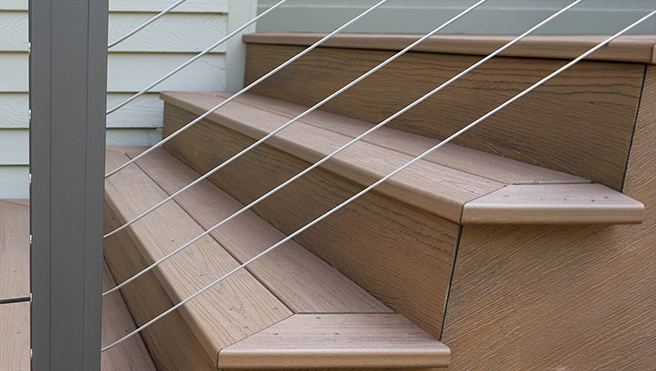Maybe your stairway is looking a bit antique despite your home only being a couple of decades old, or maybe there’s a small creaking sound when you step on one of the treads, but it’s nothing major. You don’t need stair repair—right?
Whether you have major functional issues or minor cosmetic issues, stair repair is always a valid option. Small problems are preliminary warning signs you need stair repair. Some instances in which you should definitely consider repairs include:
- Creaky stairs
- Loose newel posts or handrails
- Wood rot
- Cracked or otherwise damaged treads
- Damaged balusters or railings
- Faded hardwood stairs
- Peeling paint
- Scuffs and scratches
- While planning a new flooring installation
For minor issues and major repairs, you can trust our service professionals to complete your Darien stair repair project according to code and with a high standard of workmanship.
How We Tackle Stair Repair in Darien, CT
Just like the wide range of services we offer, there are many different materials and designs used in residential and commercial stairways today. Stair repair in Darien, CT, generally involves repairing the following types and materials of staircases:
- Attic stairs
- Wooden stairs
- Concrete steps
- Tile flooring steps
- Vinyl steps
- Carpet steps And more
If you’re getting your flooring redone completely, you may wish to have your entire staircase replaced. Otherwise, we can repair individual steps as needed to preserve your existing staircase.
The tools required for stair repair vary depending on the type of repair required. When you call our handyman experts, they’ll arrive in uniform and on time in a branded vehicle loaded full of their tools. You can rest assured that they will have all the equipment needed to complete the repair so that you don’t have to worry about digging through your garage’s messy and perhaps neglected tool chest.
Each Darien stair repair appointment will follow a different procedure that is tailored specifically to your project needs. Typically, you can expect our process to look similar to the following steps:
Step 1: Inspect And Diagnose
Stairs are made up of a myriad of parts, from treads and risers to newel posts and balusters. While some causes of issues are obvious (like gnaw marks on the edge of the treads that look suspiciously similar to the teeth marks left on your dog’s favorite chew toy), others will take a little more time to diagnose. One such problem that may not be immediately obvious is wood rot.
One of the most important things to know about wood rot is that it’s difficult to stop its spread once it’s begun. Stairs that are made from plywood and then covered with a material like carpet or vinyl may have wood rot going on beneath the surface. Solving this problem will be more complicated than simply fixing a loose tread board, but once we’ve determined how the rot has occurred, we’ll be able to create an action plan for repair.
Step 2: Conduct The Stair Repair
Now that we know what caused the issue, we can get started on repairing it. Because the types of repairs required will vary significantly from customer to customer, it’s difficult to provide specific information on what the process will look like. However, you can rely on your service professional to explain the scope of the problem, the pros and cons of different repair options and the timeframe and cost of the repair itself. Typically, you’ll find that we do the following types of repairs for these common issues:
If your stairs are pulling away from the wall in an open staircase, we may reattach them with a special type of bolts.
Creaking treads and risers are often the result of loosening joints. To fix this, we’ll hammer the corresponding carpentry back into place, as long as it’s still in good condition. Otherwise, we’ll replace them.
Loose balusters can be secured by inserting wedges, screws and/or adhesive into sockets. Cosmetic issues such as scuffs, scratches, dirty or peeling paint and faded stains may be repaired by sanding down and refinishing your steps.
Any visible work or gaps present following repairs can be hidden with caulk or trim. Our interior trim repair guide can help you determine whether adding some trim work to your staircase may be right for you.
Having options and a firm understanding of the steps that need to be taken will help you make the most informed decision. We want you to be fully comfortable with the plan of action before going forward. It’s your home, thus the final decision is yours, and yours alone.
Step 3: Finishing Touches
Once we’ve fixed or eliminated the problem you were experiencing, we’ll test it out and walk you through the changes we made. We’ll do our best to provide you with all the information you may need, including aftercare tips, but we encourage you to ask us any remaining questions you may have at this point.
To finish up your service, we’ll ensure that we thoroughly clean up after ourselves so that your home is left in the same condition we found it—except for the improved staircase we’ll leave you with.





